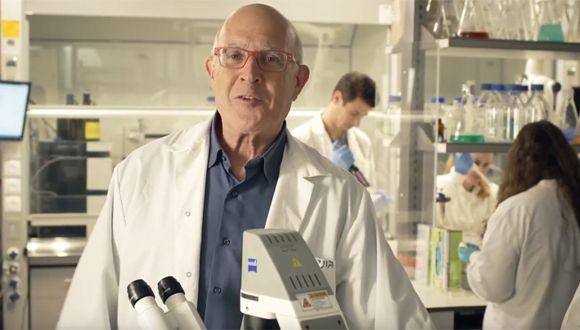The patent, approved in March, covers a vaccine that targets the most vulnerable point in a coronavirus’s structure, through which it penetrates human cells

Credit: American Friends of Tel Aviv University (AFTAU)
Researchers worldwide are racing at breakneck speed to develop potential vaccines and drugs to fight the novel coronavirus, SARS-Cov-2. Now, the United States Patent and Trademark Office (USPTO) has granted a patent to Tel Aviv University’s Prof. Jonathan Gershoni of the School of Molecular Cell Biology and Biotechnology at TAU’s George S. Wise Faculty of Life Sciences for his innovative vaccine design for the corona family of viruses.
The vaccine targets the novel coronavirus’s Achilles’ heel, its Receptor Binding Motif (RBM), a critical structure that enables the virus to bind to and infect a target cell.
According to Prof. Gershoni, the vaccine would reconstruct the coronavirus’s RBM, a tiny feature of its “spike” protein. Though the virus uses many different proteins to replicate and invade cells, the “spike” protein is the major surface protein that it uses to bind to a receptor — another protein that acts like a doorway into a human cell. After the spike protein binds to the human cell receptor, the viral membrane fuses with the human cell membrane, allowing the genome of the virus to enter human cells and begin infection.
“We have been working on coronaviruses for the last 15 years, developing a method of reconstructing and reconstituting the RBM feature of the spike protein in SARS CoV and subsequently in MERS CoV,” explains Prof. Gershoni. “The moment the genome of the new virus was published in early January 2020, we began the process of reconstituting the RBM of SARS CoV2, the virus that causes COVID-19, and expect to have a reconstituted RBM of the new virus soon. This will be the basis for a new vaccine, which could be ready for use within a year to a year and a half.”
The spike protein is quite large, containing about 1,200 amino acids. Some researchers have limited their research to a region of the spike known as the receptor binding domain (RBD) that comprises some 200 amino acids. However, the problem is that these relatively large areas have a variety of targets, and the immune system produces antibodies for all of them indiscriminately — reducing the effectiveness of a potential vaccine.
The RBM, a highly complex three dimensional structure, is only 50 amino acids long. Functionally reconstituting such a structure would be very challenging, but it would be an extremely effective basis of a vaccine, says Prof. Gershoni.
“The smaller the target and the focus of the attack, the greater the effectiveness of the vaccine,” he adds. “The virus takes far-reaching measures to hide its RBM from the human immune system, but the best way to ‘win the war’ is to develop a vaccine that specifically targets the virus’s RBM.”
Prof. Gershoni’s team has completed their initial steps toward reconstituting the new SARS CoV2’s RBM. The reconstitution of the new SARS CoV2’s RBM and its use as a basis for a new vaccine is covered by an additional pending patent application, filed by Ramot, TAU’s technology transfer arm, to the USPTO.
“Now that we have received serum samples we should be able to isolate RBM-based vaccine candidates in the next month or two,” concludes Prof. Gershoni. “The discovery and production of a functional RBM for the new coronavirus is fundamental and critical for the production of the vaccine we propose.
“Our successful isolation and reconstitution of such a functional RBM will allow the industry to incorporate it into a vaccine, which will be produced by a pharmaceutical company. Development of such an RBM-based vaccine should take months and then would need to be tested in Phase 1, 2 and 3 clinical trials which would then take up to a year.”
###
American Friends of Tel Aviv University supports Israel’s most influential, comprehensive and sought-after center of higher learning, Tel Aviv University (TAU). TAU is recognized and celebrated internationally for creating an innovative, entrepreneurial culture on campus that generates inventions, startups and economic development in Israel. TAU is ranked ninth in the world, and first in Israel, for producing start-up founders of billion-dollar companies, an achievement that surpassed several Ivy League universities. To date, 2,500 US patents have been filed by Tel Aviv University researchers — ranking TAU #1 in Israel, #10 outside of the US and #66 in the world.
Media Contact
George Hunka
[email protected]
Original Source
https:/




